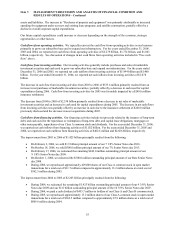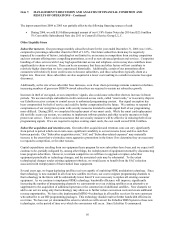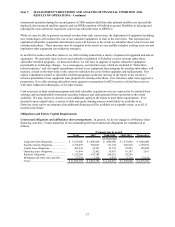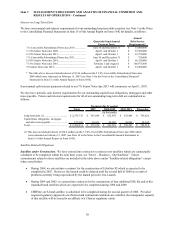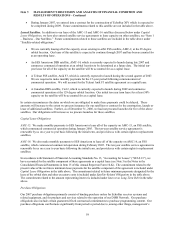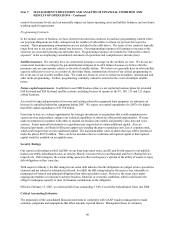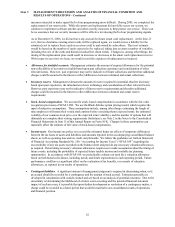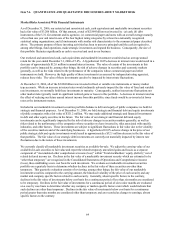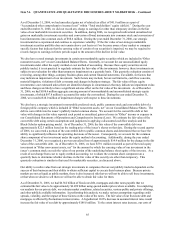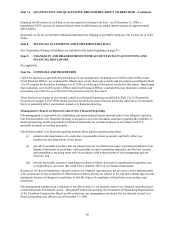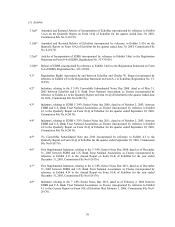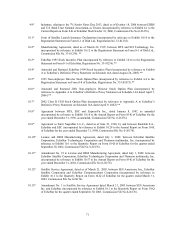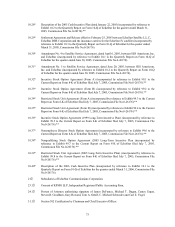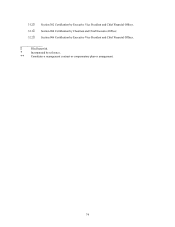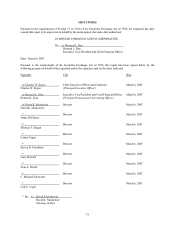Dish Network 2005 Annual Report Download - page 75
Download and view the complete annual report
Please find page 75 of the 2005 Dish Network annual report below. You can navigate through the pages in the report by either clicking on the pages listed below, or by using the keyword search tool below to find specific information within the annual report.Item 7A. QUANTITATIVE AND QUALITATIVE DISCLOSURES ABOUT MARKET RISK – Continued
65
As of December 31, 2006, we had unrealized gains net of related tax effect of $41.8 million as a part of
“Accumulated other comprehensive income (loss)” within “Total stockholders’ equity (deficit).” During the year
ended December 31, 2006, we did not record any charge to earnings for other than temporary declines in the fair
value of our marketable investment securities. In addition, during 2006, we recognized realized and unrealized net
gains on marketable investment securities and conversion of bond instruments into common stock and conversion of
bond instruments into common stock of $88.6 million. During the year ended December 31, 2006, our strategic
investments have experienced and continue to experience volatility. If the fair value of our strategic marketable
investment securities portfolio does not remain above cost basis or if we become aware of any market or company
specific factors that indicate that the carrying value of certain of our securities is impaired, we may be required to
record charges to earnings in future periods equal to the amount of the decline in fair value.
We also have several strategic investments in certain non-marketable equity securities which are included in “Other
noncurrent assets, net” on our Consolidated Balance Sheets. Generally, we account for our unconsolidated equity
investments under either the equity method or cost method of accounting. Because these equity securities are not
publicly traded, it is not practical to regularly estimate the fair value of the investments; however, these investments are
subject to an evaluation for other than temporary impairment on a quarterly basis. This quarterly evaluation consists of
reviewing, among other things, company business plans and current financial statements, if available, for factors that
may indicate an impairment of our investment. Such factors may include, but are not limited to, cash flow concerns,
material litigation, violations of debt covenants and changes in business strategy. The fair value of these equity
investments is not estimated unless there are identified changes in circumstances that may indicate an impairment exists
and these changes are likely to have a significant adverse effect on the fair value of the investment. As of December
31, 2006, we had $188.6 million aggregate carrying amount of non-marketable and unconsolidated strategic equity
investments, of which $97.8 million is accounted for under the cost method. During the year ended December 31,
2006, we recorded $18.0 million of impairment charges with respect to these investments.
We also have a strategic investment in non-public preferred stock, public common stock and convertible debt of a
foreign public company which is included in “Other noncurrent assets, net” on our Consolidated Balance Sheets. The
debt is convertible into the issuer’s publicly traded common shares. We account for the convertible debt at fair
value with changes in fair value reported each period as unrealized gains or losses in “Other” income or expense in
our Consolidated Statements of Operations and Comprehensive Income (Loss). We estimate the fair value of the
convertible debt using certain assumptions and judgments in applying a discounted cash flow analysis and the
Black-Scholes option pricing model. As of December 31, 2006, the fair value of the convertible debt was
approximately $22.5 million based on the trading price of the issuer’s shares on that date. During the second quarter
of 2006, we converted a portion of the convertible debt to public common shares and determined that we have the
ability to significantly influence the operating decisions of the issuer. Consequently, we account for the common
share component of our investment under the equity method of accounting. Additionally, during the year ended
December 31, 2006, we recognized a pre-tax unrealized loss of approximately $14.9 million for the change in the fair
value of the convertible debt. As of December 31, 2006, we have $59.1 million recorded as part of the total equity
investment in “Other non-current assets, net” for the amount by which the carrying value of our investment in the
issuer’s common stock exceeds the value of our portion of the underlying balance sheet equity of the investee. As a
result of our change from cost to equity method accounting, we evaluate the common share component on a
quarterly basis to determine whether declines in the fair value of this security are other than temporary. This
quarterly evaluation is similar to that used for marketable securities, as discussed above.
Our ability to realize value from our strategic investments in companies that are not publicly traded is dependent on the
success of their business and their ability to obtain sufficient capital to execute their business plans. Because private
markets are not as liquid as public markets, there is also increased risk that we will not be able to sell these investments,
or that when we desire to sell them we will not be able to obtain fair value for them.
As of December 31, 2006, we had $6.562 billion of fixed-rate debt, mortgages and other notes payable that we
estimated the fair value to be approximately $6.499 billion using quoted market prices where available. In completing
our analysis for our private debt, we evaluate market conditions, related securities, various public and private offerings,
and other publicly available information. In performing this analysis, we make various assumptions regarding credit
spreads, volatility, and the impact of these factors on the value of the notes. The fair value of our fixed-rate debt and
mortgages is affected by fluctuations in interest rates. A hypothetical 10.0% decrease in assumed interest rates would
increase the fair value of our debt by approximately $186.8 million. To the extent interest rates increase, our costs of


